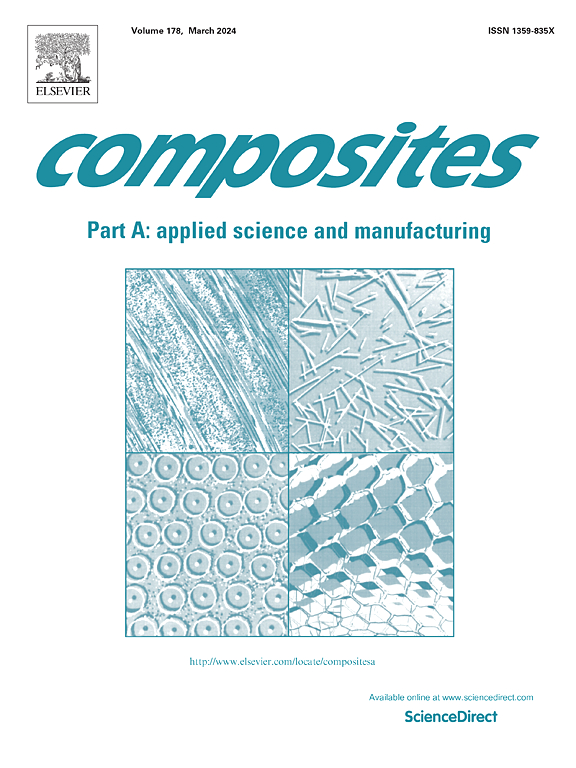Influence of electrically aligned carbon nanofiber Z-threading on the fatigue behavior of CFRP composites
IF 8.1
2区 材料科学
Q1 ENGINEERING, MANUFACTURING
Composites Part A: Applied Science and Manufacturing
Pub Date : 2025-07-21
DOI:10.1016/j.compositesa.2025.109193
引用次数: 0
Abstract
A rapid fatigue characterization method using full-field temporal surface temperature measurements has been used to study the effect of microstructural modification in unidirectional carbon fiber reinforced plastics (UD-CFRP) via electrically aligned Z-threaded carbon nanofibers (CNF). 1 wt% CNF were aligned in the Z-direction via electric means using a patented roll-to-roll process, enabling ZT-CNF-CFRP prepreg production. Three configurations were tested under fatigue: ZT-CNF-UD-CFRP (ZTE), UD-CFRPs with Unaligned CNF, and UD-CFRPs without CNF (Control). Mean surface temperatures measured via passive infrared thermography (IRT) was used to estimate the fatigue limit for these materials using a staircase loading method. Further, harmonic analysis of the obtained temporal full-field temperature data was used to monitor the damage evolution. Finally, the fatigue limit was also determined using the residual threshold method based on the second harmonic signal. Fatigue limits obtained for the three configurations via the bi-linear method were 62.36 ± 0.42 % for ZTE, 64.7 ± 1.83 % for Unaligned and 49.29 ± 2.47 % for Control. While the presence of 1 wt% CNF improves the fatigue limit; the effect of Z-threading could not be accurately quantified since the Z-threading manufacturing process was found to increase the matrix content of the composite. CNF Z-threads increased thermal conductivity, enabling better in situ damage monitoring. Different failure modes were found and discussed to understand the roles of CNF in the fatigue behavior of UD-CFRP laminates.
电取向纳米碳纤维z型螺纹对CFRP复合材料疲劳性能的影响
采用一种基于现场时间表面温度测量的快速疲劳表征方法,研究了电取向z螺纹碳纳米纤维(CNF)对单向碳纤维增强塑料(UD-CFRP)微结构改性的影响。使用专利的卷对卷工艺,通过电子手段将1 wt%的CNF对准z方向,从而实现ZT-CNF-CFRP预浸料的生产。在疲劳下测试了三种配置:ZT-CNF-UD-CFRP(中兴),ud - cfrp未对准CNF, ud - cfrp未对准CNF(对照)。利用被动红外热像仪(IRT)测量的平均表面温度,采用阶梯加载法估计了这些材料的疲劳极限。此外,对获得的时域全场温度数据进行谐波分析,监测损伤演变。最后,采用基于二次谐波信号的残差阈值法确定了疲劳极限。通过双线性方法得到的三种配置的疲劳极限分别为:中兴型号为62.36±0.42%,未对准型号为64.7±1.83%,控制型号为49.29±2.47%。而1 wt% CNF的存在提高了疲劳极限;由于发现z螺纹加工工艺增加了复合材料的基体含量,因此无法准确量化z螺纹加工的影响。CNF z型螺纹提高了导热性,能够更好地进行现场损伤监测。发现并讨论了不同的破坏模式,以了解CNF在UD-CFRP层合板疲劳行为中的作用。
本文章由计算机程序翻译,如有差异,请以英文原文为准。
求助全文
约1分钟内获得全文
求助全文
来源期刊

Composites Part A: Applied Science and Manufacturing
工程技术-材料科学:复合
CiteScore
15.20
自引率
5.70%
发文量
492
审稿时长
30 days
期刊介绍:
Composites Part A: Applied Science and Manufacturing is a comprehensive journal that publishes original research papers, review articles, case studies, short communications, and letters covering various aspects of composite materials science and technology. This includes fibrous and particulate reinforcements in polymeric, metallic, and ceramic matrices, as well as 'natural' composites like wood and biological materials. The journal addresses topics such as properties, design, and manufacture of reinforcing fibers and particles, novel architectures and concepts, multifunctional composites, advancements in fabrication and processing, manufacturing science, process modeling, experimental mechanics, microstructural characterization, interfaces, prediction and measurement of mechanical, physical, and chemical behavior, and performance in service. Additionally, articles on economic and commercial aspects, design, and case studies are welcomed. All submissions undergo rigorous peer review to ensure they contribute significantly and innovatively, maintaining high standards for content and presentation. The editorial team aims to expedite the review process for prompt publication.
 求助内容:
求助内容: 应助结果提醒方式:
应助结果提醒方式:


